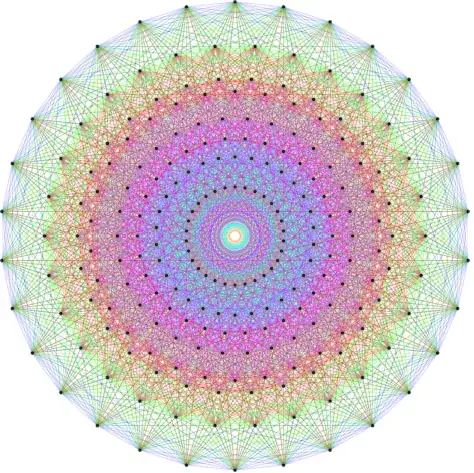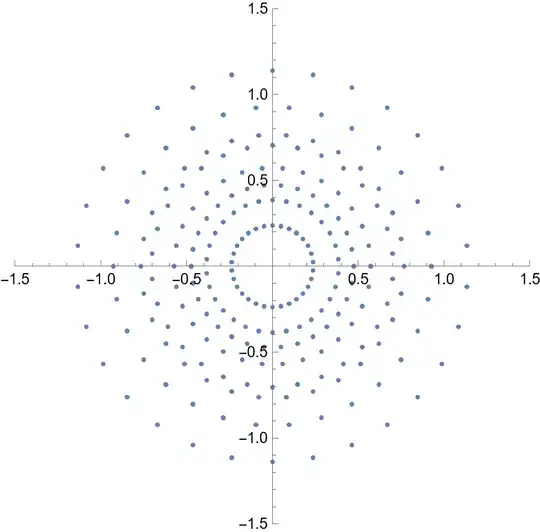The explanation by John Stembridge (credit to Sabino Di Trani for linking there) is a great starting (and perhaps even end) point. I quote the beginning:
The Lie group E8 has a "root system" associated to it that consists of 240 points in 8-dimensional space. Similarly, the Lie group E7 has a root system of 126 points in 7-dimensional space.
These 240 points are tightly packed together in a highly symmetric way. In fact, this configuration has a total of 696,729,600 symmetries. Contrast this with what happens if you take the 8 points at the corners of a 3-dimensional cube. These 8 points have "only" 48 rotational and reflective symmetries.
Of course we can't really visualize any objects in 8 dimensions, but we can draw 2-dimensional projections of them. For example, if you imagine shining a flashlight on a cube, the shadow it casts would (depending on how you orient the cube) look like a hexagon. And if you orient the cube just right, the shadow it casts would look like a regular hexagon--a six sided figure with all sides of equal length and all angles of equal measure. Taking it one step further, if you imagine the cube as a wire frame -- 8 points together with links that connect along edges of the cube, then the projection would look like 6 dots at the corners of a hexagon, plus another dot in the center, plus lines connecting nearby dots.
What I've done with the root system of E8 is completely analogous. I picked the "just right" direction to shine a light on these 240 points so that the 2-dimensional shadow they cast is as symmetric as possible.
So the primary question this leaves open is: "what is a root system?", and related: why would we be drawing a root system when we are talking about a group?
There is a more general issue here. When people talk about $E_8$ they sometimes refer to a real Lie group, sometimes to a complex Lie group, sometimes to a complex Lie algebra, sometimes (but rarely) to a real Lie algebra, sometimes to a Coxeter group, sometimes to a lattice, sometimes to a root system and in exceptional cases to something else (e.g. singularities in two-dimensional algebraic geometry).
Often people are sloppy about to which thing they are referring and this is somewhat justified by how these things are all related and the fact that you can create the one from the other.
But lots of things are related in math and they do not all get the same name, so it is good to spend a few seconds of thought on why it happens in this case.
The short answer is that all these types of mathematical objects follow (roughly) the same classification, the ADE classification. In every class of object mentioned we have one (or a few closely related ones) called $A_n$ for every value of $n$, one (with the same caveat) called $D_n$ for every value of $n$, one (...) called $E_6$, one (...) called $E_7$ and one (...) called $E_8$. Also for some classes of objects there are others that get different letter-number combinations, but not many.
The same correspondences between groups, algebras, lattices etc we get for $E_8$ we get for every $A_n$, $D_n$ and $E_n$.
Now to the question what I recommend you to do:
- If you want to get some overview of how many things follow this magical ADE classification, read John Baez on this topic. I will try and find a link later and edit it in.
- If you really want to follow the full story from Lie group to Lie algebra to Coxeter group to root system (and hence this picture) I recommend doing this not for the hardest case ($E_8$) but for the second-simplest case $A_2$ (the simplest case $A_1$ is so simple that you might miss out on some of the beauty). A great resource for this is the book 'Representation Theory, a first course' by Fulton and Harris.
- If you don't want the full story but only the part that is easy to understand and visualize (in as far as things beyond 3 dimensions are visualizable) I recommend you skip the Lie groups and Lie algebras and start with Coxeter groups. For this Wikipedia is a very rich source.
- If you just want an informal answer here to the question what is a root system, I recommend you start with lattices.
Concretely: a lattice is just a very regular way to place points in space. In 2 dimensions you have the square lattice (the crossings in ordinary grid paper) but you also have the $A_2$ lattice, the crossings in triangular grid paper, as well as a few others. You can see that the $A_2$-lattice is really really nice (and hence deserving of its own letter) by putting circles (coins) around the points of the lattice and see how they all touch each other with no room to wiggle. This type of niceness does not exist in every dimension (the best resource for this stuff is the book by Conway and Sloane: 'Sphere packings, Lattices and [something]') but in eight dimension everything falls into place nicely again and you get a really nice lattice, the $E_8$ lattice. I like this (really informal) description because it gives me the feeling that I can almost picture it although in reality I can't of course picture anything.
Now if you have some feeling about what lattices are and why they are nice objects, the root system is pretty much just the 'inner shell' of the lattice: the points closest to the origin (together with info of their distances and angles between them) which generate the full lattice simply by adding them together as vectors.
EDITED IN LATER: let me try and answer the concrete questions from the original post.
One take-away from my last paragraph above is that lattices and hence root systems are really rigid objects. It is old school geometry: distances, angles, location in space all still have their standard meaning here. Nothing is abstracted away into topology or linear algebra or defined over an abstract field, it is just the good old way of thinking about geometry you had in primary school, except of course for the fact that you don't restrict yourself to only 3 dimensions. As a result of this it makes perfect sense to pick an arbitrary (or not so arbitrary) two-dimensional plane in the space where the lattice and root system live and consider the orthogonal projection of the root system onto that plane.
That is what this is.
So to answer the first question:
What do the vertices represent?
The vertices are the actual locations of the projections ('shadows') of the elements of the root system (which themselves are by their nature points in space) onto a cleverly chosen plane.
The 'cleverly chosen' part is important here. You can imagine that if you would have picked a random 2D-plane to project on, the configuration of vertices would be a lot less symmetric. This brings us to the second question:
Does this diagram have a name?
As far as I know: no. But the plane onto which the root system is projected, which yields the incredibly nice rotational symmetry, does. It is the Coxeter plane. So one name for the diagram is The projection of the root system [of $E_8$] onto the Coxeter plane. I put the 'of $E_8$' into block brackets because you could make similar pictures for $A_2$, $D_4$ etc.
Now:
What do the edges represent?
Edges connect each vertex to the vertices that in the actual root system are its nearest neighbors. The fact that some of the edges run between vertices that are no longer nearest neighbors in the projection suggests that the original root system was projected down from a space with more than 2 dimensions. In fact it came from a space with 8 dimensions. We sort of already knew that, of course; the subscript 8 in $E_8$ was a bit of give-away.
Finally:
What does the color code represent?
As far as I can tell from the link in the other answer: not much. One thing that is so nice and special about the Coxeter plane is that the roots (that is what elements of a root system are called) are projected into a relatively small number of rings (instead of all over the place). The colors reflect that. Colors are assigned one color to each ring and then each edge is colored in the color of the outermost ring it has a vertex in. As far as I can tell this functions mostly for making the picture more transparent. In as far as the colors have a deeper meaning which could be described in the original 8-dimensional setting without bringing in the Coxeter plane, they thus represent a property of the vertices rather than of the edges.


